What are the latest North American trailer innovations?
19 July 2022
Successfully hauling wind tower components or other specialized cargoes often starts with the trailer. They can range from mass production trailers and transport systems to special one-offs made just for a particular hauling challenge. ACT rounded up a few of the latest trailer innovations.
K25 scores in wind
When developing the new modular K25 L platform vehicle, Scheuerle focused on safety and hauling loads with a high center of gravity, which is needed for transporting wind turbine components.
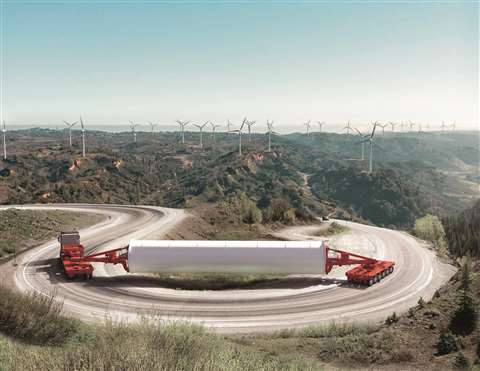 Optimized to meet the needs of wind power haulers, the K25 L from Scheuerle is a modular platform vehicle that was designed for transporting loads with a high center of gravity.
Optimized to meet the needs of wind power haulers, the K25 L from Scheuerle is a modular platform vehicle that was designed for transporting loads with a high center of gravity.
With new wind turbines designed higher and heavier, the high center of gravity of the load requires an extremely stable means of transport. Scheuerle, a subsidiary of the TII Group, developed the modular K25 L series platform vehicles for ensuring the maximum stable and flexible transport of such products. The L (Low) indicates the particularly low platform height along with the use of larger tires. The track width of the K25 L is 2,100 millimeters along with an external width of 3,000 millimeters.
The axle load of the K25 L is up to 23 tons or up to 13.9 tons at 49 mph. The tires are larger and more robust: 285/70 R 19.5. In spite of the larger tires, the lowered platform height is 875 millimeters (loaded) or 910 millimeters (unloaded). The high axle compensation of 680 millimeters also makes driving on uneven surfaces safer. The maximum steering angle of +/- 60 degrees ensures optimal maneuverability. Lifting and lowering is carried out with the help of a Power Pack Unit (PPU) from the Z19 series. This is low-emission and in accordance with Stage V.
The highest negative and positive bending moment on the market creates economic flexibility for the operator through additional loading options. This offers particular advantages for products such as tower segments or nacelles that feature high point loads in combination with a high center of gravity, and those whose center of gravity lies far outside the support center, as is the case when transporting long blades. For cornering safety, the K25 L has a 30 percent higher torsional stiffness compared to similar products. EBS ensures enhanced braking performance and a shorter braking distance. Depending on the truck tractor, troubleshooting is possible from the driver’s cab. The model range of the K25 L series fulfils the requirements of platform vehicles with two to six axles. The vehicles can be combined with goosenecks, drawbars, swivel bolsters, bridges and tower adapters and can be used in ambient temperatures reaching minus 25 degrees.
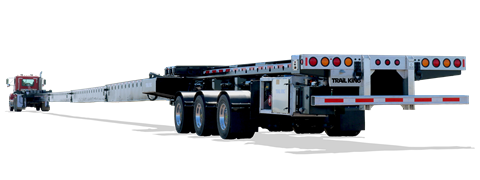
Trail King’s EFX Extendable trailer will accommodate a variety of wind turbine blade sizes, styles and lengths. The Extendable’s narrow, double-telescopic, mono-frame
main and low-profile gooseneck keep the overall dimensions to a minimum. Extra-long blades can be maneuvered while in transit or at the jobsite with hydraulic turntable-style steering.
BladeMate Flip Extension
XL Specialized Trailers produces the BladeMate Flip Extension for hauling longer wind turbine blades. XL’s 27-foot-long Flip Extension can be added to the rear of XL’s BladeMate trailer, or any blade-hauling trailer. The trailer length depends on the model the Flip Extension is paired with. Adding the Flip Extension, XL’s BladeMate reaches to a length of 211 feet. When moving the empty trailer, a driver can flip up the Extension, retract the trailer and have a 53-foot-long return trip with reduced permit costs.
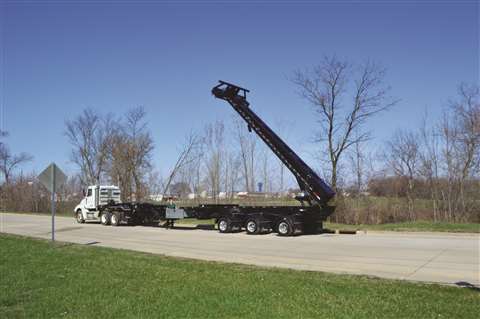 The XL BladeMate Flip Extension offers benefits to the driver even when hauling shorter blades.
The XL BladeMate Flip Extension offers benefits to the driver even when hauling shorter blades.
The XL Blademate Flip Extension is user-friendly. By moving the lever at the front of the trailer, six-inch hydraulic cylinders flip the Extension up or down within minutes. The cylinder linkage can be unpinned and lowered flat to allow for more loading space.
The rear bolster, at the end of the Flip Extension, offers a 20,000-pound capacity, making it suitable as the rear-loading platform for the common two-point load set-up. The Flip Extension is secured with a lug and pin system, allowing the tail to be completely removed when it is not needed.
Powering the grid with Energieanlagen Ramonat
Getting the electricity generated from solar panels or wind turbines to where it is needed requires cables – very long cables. With a team of over 100 specialists, Energieanlagen Ramonat hauls and installs cable routes all over the world – from planning to installation and maintenance to dismantling and disposal.
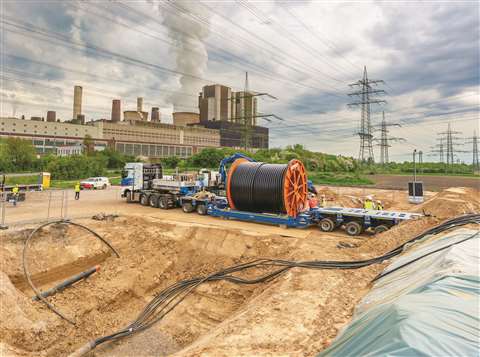 The Goldhofer THP/SL-L is ideal for transporting cable spools from wind farms to the power grid.
The Goldhofer THP/SL-L is ideal for transporting cable spools from wind farms to the power grid.
Depending on the cable design and length, which can be up to 1.25 miles, the weights of the cable drums range from 55 tons at present to around 100 tons in the future. In addition to the high load weight, the drum dimensions also need to be considered – both during transport to the construction site and during subsequent maneuvering on different construction site topographies during uncoiling.
The company mainly uses Goldhofer THP/SL-L heavy-duty modules with vessel bridges. These systems offer an optimal dead weight-to-payload ratio and many combinations, as well as high torsional stiffness and good off-road capability.
In addition, the use of self-propelled units (»ADDRIVE«) is possible, increasing operational flexibility at lower investment costs. To cope with the increasingly high-volume cable loads, Goldhofer is developing an optimized vessel bridge to accommodate an unwinding device for drums weighing up to 100 tons.
“The combination of the THP/SL-L modules with the vessel bridges, which are only 450, 500 or 650 millimeters high and up to 13 meters long, is the optimum heavy transport solution for our cable drums. It is flexible to use and has already saved us many time-consuming detours,” said Energieanlagen Ramonat, managing director, Stefan Ramonat.
Making the right choice
When purchasing a lowboy trailer, there are a lot of considerations in selecting the best trailer for your business. Purchasing the wrong one can not only cost you in the long term, but it may also have an immediate impact if you are unable to use it to haul the necessary equipment. It’s important to thoroughly research lowboy trailers in advance to help you avoid trailer failures in the future.
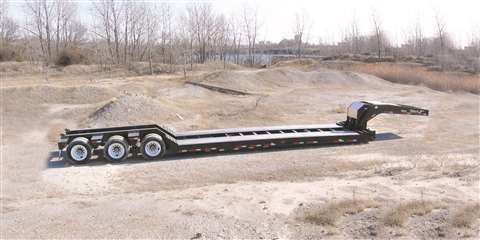 Ensuring safe weight distribution, axle loads and load positioning, hydraulic and mechanical gooseneck trailers provide safe and efficient heavy hauling.
Ensuring safe weight distribution, axle loads and load positioning, hydraulic and mechanical gooseneck trailers provide safe and efficient heavy hauling.
Talbert Manufacturing offers a wide range of heavy haul solutions, including a series of lowboy trailer models with a removable gooseneck that is available in either a hydraulic or mechanical configuration. While most contractors choose hydraulic goosenecks for ease of use, there may be some situations where a mechanical gooseneck is preferred.
One of the main benefits a hydraulic gooseneck trailer offers is its ability to quickly attach and detach to save on downtime and labor costs. Hydraulic goosenecks also utilize a series of hydraulic cylinders to safely and easily lower and lift the deck when the trailer is attached to the truck while maintaining a low center of gravity when the loaded equipment is particularly tall. Additionally, if an operator knows there will be rough terrain or overhead clearances during transport, the front deck height of the hydraulic gooseneck can be adjusted to accommodate its surroundings. Hydraulic gooseneck trailers also offer enhanced safety for the operator, as the neck can be raised to allow the truck’s fifth wheel to attach without requiring the main deck to be lifted.
Varying capacities
Operations can further optimize their hydraulic gooseneck trailer by adding additional shims for weight distribution.
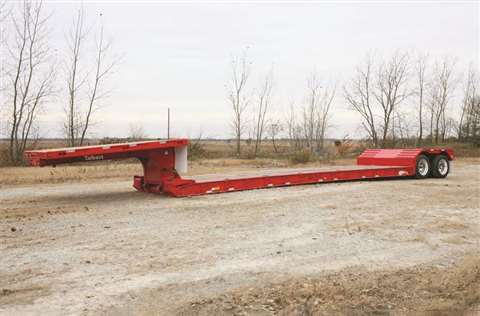
Hydraulic goosenecks are available in Talbert Manufacturing’s double drop series, which are available with an 18-inch loaded deck height to ensure ample clearance and stability for tall loads and air suspension to provide maximum control over the load, as well as the lowboy series, which has a weight capacity of up to 110,000 pounds.
Mechanical goosenecks are lighter weight than hydraulic goosenecks, however, they take more time to attach and detach. They are also a lower cost than hydraulic goosenecks and require less maintenance. Mechanical goosenecks utilize front rollers and truck ramps to connect and disconnect. These are best suited for longer-distance trucking companies, where the load will be on the truck for several days and unloading will occur on smooth, hard surfaces.
STAY CONNECTED


Receive the information you need when you need it through our world-leading magazines, newsletters and daily briefings.



